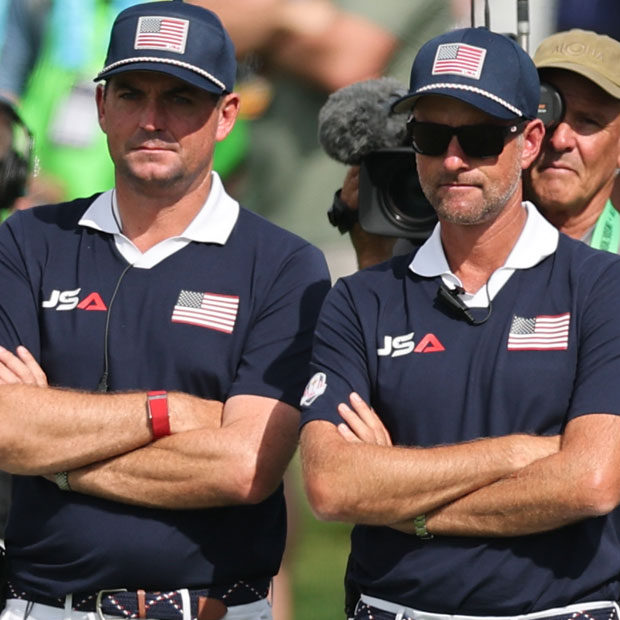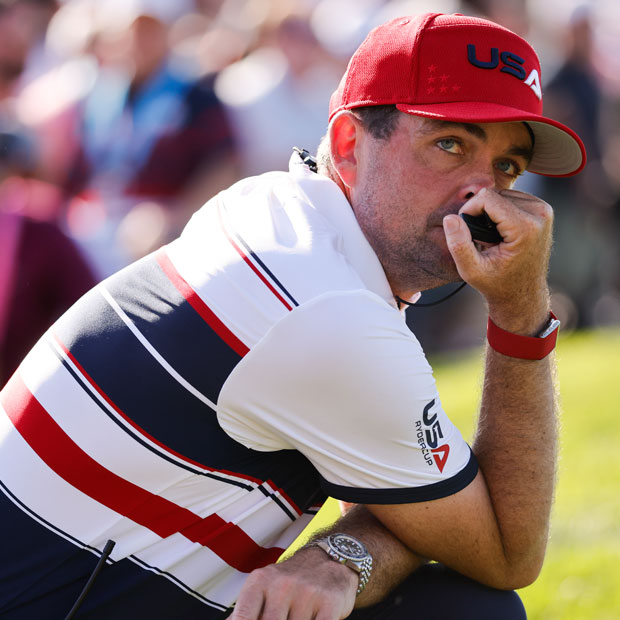Old Town Club
A 2013 restoration by Coore & Crenshaw recaptured Perry Maxwell’s naturalistic aesthetics, rippling greens, and width-based strategic design at this late masterpiece of Golden Age design

Winston-Salem, North Carolina, USA
Perry Maxwell (original design, 1939); Bob Cupp (renovations, 1996); Bobby Weed (renovations, 2002); Coore & Crenshaw (restoration, 2013)
Private
$$$
Puffs and Tilts: Old Town Club
Maxwell’s Muffins
Reynolds Park and Old Town Club
In 1938, heirs of the Reynolds Tobacco family in Winston-Salem, North Carolina, hired Perry Maxwell to build a golf course on the R.J. Reynolds Estate, nicknamed “Reynolda.” Maxwell had the pick of 1,003 acres, and he went with a hilly but walkable 165-acre parcel, formerly a horse farm. His 18-hole design for Old Town Club debuted in November of 1939, becoming one of the last and most brilliant expressions of Golden Age golf architecture. Over the decades, Maxwell’s layout remained intact, though many of the fine details became smudged as the club planted trees and modernized bunkers and greens. In the early 2000s, however, golf chairman Dunlop White III—also the restoration chairman at Roaring Gap Club—began pushing for course changes based on historical research. White’s effort culminated in a 2013 restoration by Coore & Crenshaw, which recaptured Maxwell’s naturalistic aesthetics, rippling greens, and width-based strategic design.
(Note: Old Town Club underwent additional renovations over the past several months and is once again open for play.)
{{content-block-course-profile-old-town-club-001}}
Take Note…
Men in green. In our video on Old Town Club, Yale golf coach Colin Sheehan says of the course, “That’s what Augusta wants to be.” This isn’t just a random comparison; the two Southern clubs have a historical connection. Old Town was founded by Mary Reynolds Babcock, daughter of tobacco baron R.J. Reynolds, and her husband Charles Babcock, an investor who did business with Augusta National co-founder Clifford Roberts. In 1937 and 1938, Roberts enlisted the services of Perry Maxwell to rebuild Augusta’s seventh and 10th greens. Roberts then recommended Maxwell to Babcock for the Old Town project. During Old Town’s construction, the Augusta National chairman visited the site and encouraged Maxwell to merge adjacent eighth and 17th greens into an impressive double green, which now serves as the focal point of the northwestern portion of the course. Certainly a better design idea than this one!
Town-gown relations. Just behind the 8-17 double green and to the left of the 12th tee is an unassuming pathway that provides entry to and egress from the golf course. From there, it’s a short walk to the Arnold Palmer Golf Complex, the practice facility for the Wake Forest University golf team. Wake Forest moved next door to Old Town Club in 1946 in order to occupy a 350-acre gift of land from the Reynolds family.
Se7en. After Old Town Club opened, Perry Maxwell deemed it “one of the seven finest” golf courses in the United States. Any guesses as to the other six on his list? WHAT’S IN THE BOX?
Overall Thoughts
Perry Maxwell’s Old Town Club is often referred to as the last great course of the Golden Age of American golf architecture. I think it should also be considered a culmination of that era—a paragon of naturalistic design, executed with remarkable skill and judgment. As restored and refined by Coore & Crenshaw, Old Town is the most fully realized example of Perry Maxwell’s work.
Bill Coore attributes the course’s greatness to two main factors: routing and green contouring.
Maxwell’s routing at Old Town wrings everything out of the rolling and varied property. No hole is flat, and no two holes use the land in the same way. The player is led on a balanced sequence of uphill, downhill, sidehill, ridge-to-ridge, and valley-to-valley walks. As a result, the course does not rely on built features to make each hole memorable. Instead, what sticks in the player’s mind is the natural terrain and vegetation, both on and off the playing corridors. Maxwell wanted the land to predominate, and he leaned on his routing expertise to avoid major earthmoving in the process of creating distinctive, strategic golf holes.
Overall Thoughts
Perry Maxwell’s Old Town Club is often referred to as the last great course of the Golden Age of American golf architecture. I think it should also be considered a culmination of that era—a paragon of naturalistic design, executed with remarkable skill and judgment. As restored and refined by Coore & Crenshaw, Old Town is the most fully realized example of Perry Maxwell’s work.
Bill Coore attributes the course’s greatness to two main factors: routing and green contouring.
Maxwell’s routing at Old Town wrings everything out of the rolling and varied property. No hole is flat, and no two holes use the land in the same way. The player is led on a balanced sequence of uphill, downhill, sidehill, ridge-to-ridge, and valley-to-valley walks. As a result, the course does not rely on built features to make each hole memorable. Instead, what sticks in the player’s mind is the natural terrain and vegetation, both on and off the playing corridors. Maxwell wanted the land to predominate, and he leaned on his routing expertise to avoid major earthmoving in the process of creating distinctive, strategic golf holes.
Equally evident at Old Town is Maxwell’s skill in green design. Unlike some modern imitations of linksy greens (like those at the upcoming Ryder Cup venue), Old Town’s are not wild for the sake of being wild. Every tilt, runoff, hump, and tier has a strategic purpose that relates to the rest of the hole. When Maxwell manufactured a feature, he made it count.
Last year, for one of our golf architecture mailbag podcasts, our friend Andy Lack asked which course a new architect should study before building his or her own. My answer is Old Town Club. It was here that Golden Age golf course design reached both its end and its peak. -Garrett Morrison
3 Eggs
Obvious Eggs go to Old Town Club’s design and presentation. The Egg for land is a trickier call, as the course lacks the topographical theatrics of three-Egg courses like Sand Hills, North Berwick, and L.A. Country Club. Yet it’s clear why Perry Maxwell selected the Old Town site from the 1,003 acres of the Reynolds estate: while not flashy, it is walkable, well-scaled to golf, and eventful throughout, containing broad slopes as well as smaller undulations. The clincher for the third Egg, though, is the club’s tree-management program, which has exposed long views of the property’s landforms, creek system, and native grasses.
Course Tour

No. 1, par 4, 426 yards
On this ridge-to-ridge opener, you can lay up short and right of the green on your second shot and card a simple bogey. Hitting the green in regulation is a nervier prospect: the ledges left and long of the green are punishing, and the bunkers on the right are worse.
{{content-block-course-profile-old-town-club-002}}
No. 2, par 3, 167 yards
The green on this handsome par 3 is 30 yards wide, accommodating a variety of pin positions, ranging from easy-ish (middle bowl) to difficult (right shelf).
{{content-block-course-profile-old-town-club-003}}
No. 3, par 4, 428 yards
This excellent par 4 shows some of Maxwell’s go-to moves at Old Town. The fairway sits on a side slope, and if you’re on the high side, you can see the green. In order to find that position, however, you need to challenge a large fairway bunker. The defining feature of the green is a central “Maxwell roll”—or “puff” (a Bill Coore-ism), or “muffin” (a Dunlop White-ism)—which messes with lag putts after imprecise approaches.
{{content-block-course-profile-old-town-club-004}}
No. 4, par 5. 526 yards
The tee shot on the third hole is plain-looking and mostly blind, but when you reach the landing zone, which turns out to be the crest of the hill, you see the undulating valley containing the course’s next 15 holes. An impressive reveal.
{{content-block-course-profile-old-town-club-005}}
No. 5, par 4, 408 yards
Those familiar with Crystal Downs, where Maxwell served as Alister MacKenzie’s on-site associate, will recognize similarities between its sixth fairway and Old Town’s fifth. Three bunkers cut into a hill run across the corridor from short right to long left. The longer carry yields a shorter approach from a better angle.
{{content-block-course-profile-old-town-club-006}}
No. 6, par 3, 190 yards
The bunker on the right looks like a threat from the tee, but it’s actually about 50 yards short. While the sixth green has a broad open front, accepting running shots along the downslope, it falls off sharply on every other side.
{{content-block-course-profile-old-town-club-007}}
No. 7, par 4, 443 yards
There’s a huge amount of room on the right half of the seventh fairway, but the green is the smallest on the course, and it favors an approach from the heavily bunkered left side.
{{content-block-course-profile-old-town-club-008}}
No. 8, par 4, 417 yards
This is your first visit to the astounding double green that houses pins for the eighth and 17th holes. In addition to being the biggest green at Old Town (right after the smallest), it is also the most intricately contoured, with numerous Maxwell rolls to navigate.
{{content-block-course-profile-old-town-club-009}}
No. 9, par 4, 469 yards
Because of the extreme nature of its topography, the ninth is not the most loved hole at Old Town, but I find the way it banks off one side of a valley and finishes on the other unique and exciting. Steering left off the tee takes the trees on the right out of play, but it leaves a long approach from a sidehill lie. A successful drive along the inside of the dogleg requires accuracy and power.
{{content-block-course-profile-old-town-club-010}}
No. 10, par 4, 410 yards
The rarely discussed 10th hole is the best example of Maxwell’s restraint at Old Town. The green simply flows out of the right-to-left-sloping land, allowing for run-up play. A subtle roll/puff/muffin in the middle differentiates pin positions.
{{content-block-course-profile-old-town-club-011}}
No. 11, par 3, 220 yards
This downhill par 3 is one of the prettiest holes on the course but also one of the more conventional. It will likely be improved by the club’s recent decision to move the tee to the right and bring the creek along the right side of the hole more into the player’s line.
{{content-block-course-profile-old-town-club-012}}
Favorite Hole
No. 12, par 4, 454 yards
Perry Maxwell’s strategic design at Old Town—like Alister MacKenzie’s at several courses Maxwell worked on, including Crystal Downs and Augusta National—often plays with angles and sightlines simultaneously.
Looked at from a satellite, the 12th hole seems to give an advantage to the player on the left side of the fairway, as the green opens up in that direction. Better angle. On the ground, though, you’ll find that the player’s view of the green is blocked by the shoulder of a hill. Worse sightline. The right side of the fairway offers the inverse: better sightline, worse angle.
Like many of my favorite holes, the 12th at Old Town can’t be solved on Google Earth. It has to be puzzled over in three dimensions.

{{content-block-course-profile-old-town-club-013}}
No. 13, par 4, 453 yards
Most of Old Town’s greens sit more or less at grade, creating a natural appearance, but the 13th green is built up, making the approach on this up-and-over par 4 particularly exacting.
{{content-block-course-profile-old-town-club-014}}
No. 14, par 4, 339 yards
The shaping of the green and green-side hazards on this terrific short par 4 has Coore & Crenshaw’s visual signature. When C&C associate Dave Axland was shaping the two back bunkers, Bill Coore asked for their lips to be raised so that the bunkers would peer at players from behind the green like “alligator eyes.”
{{content-block-course-profile-old-town-club-015}}
No. 15, par 3, 248 yards
Considering that the 15th can stretch to 250 yards, its green is surprisingly well guarded and unreceptive. So it might be best understood as a hybrid hole in the vein of L.A. North’s seventh, where the combination of a back tee and the toughest pin position—back left at Old Town, back right at L.A.—turns what’s usually a par 3 into a “drivable” par 4.
{{content-block-course-profile-old-town-club-016}}
No. 16, par 4, 367 yards
The ridgetop 16th green is one of Old Town’s centers of gravity: you can see it from many other spots on the course before you play it.
{{content-block-course-profile-old-town-club-017}}
No. 17, par 5, 629 yards
The only par 5 on the back nine, the 17th hole incorporates about three par 5s’ worth of ideas: a creek serving as a diagonal cross-hazard both off the tee and into the green, an 80-yard-wide multi-level fairway providing two distinct options on the second shot, and a return to Maxwell’s double green.
{{content-block-course-profile-old-town-club-018}}
No. 18, par 4, 443 yards
The 18th fairway climbs gradually and feeds into bunkers on the left, but if you can place your tee ball near them, you might be able to see part of the putting surface on your approach.

Additional Content
Leave a comment or start a discussion
Get full access to exclusive benefits from Fried Egg Golf
- Member-only content
- Community discussions forums
- Member-only experiences and early access to events















Leave a comment or start a discussion
Lorem ipsum dolor sit amet, consectetur adipiscing elit. Suspendisse varius enim in eros elementum tristique. Duis cursus, mi quis viverra ornare, eros dolor interdum nulla, ut commodo diam libero vitae erat. Aenean faucibus nibh et justo cursus id rutrum lorem imperdiet. Nunc ut sem vitae risus tristique posuere. uis cursus, mi quis viverra ornare, eros dolor interdum nulla, ut commodo diam libero vitae erat. Aenean faucibus nibh et justo cursus id rutrum lorem imperdiet. Nunc ut sem vitae risus tristique posuere.